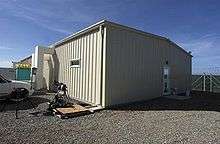Mohammad Ahmed Abdullah Saleh Al Hanashi


Mohammad Ahmed Abdullah Saleh Al Hanashi (February 1, 1978 - June 1, 2009) was a citizen of Yemen, held in extrajudicial detention in the United States Guantanamo Bay detainment camps, in Cuba.[1] Al Hanashi's Guantanamo Internment Serial Number was 78. The Department of Defense reports that Al Hanashi was born on February 1, 1978, in Al Habrub, Yemen.
On June 2, 2009, the Department of Defense reported that a 31-year-old Yemeni captive named "Muhammed Ahmad Abdallah Salih" committed suicide late on June 1, 2009.[2][3][4] Camp officials did not allow journalists who were at the camp for Omar Khadr's Guantanamo military commission to report news of his death until they left Guantanamo.
June 2009 death

Ahmed was reported to have been found "unresponsive" in his cell late on the night of June 1, 2009.[2][3][4] He is reported to have been held in Camp 5, and to have been held in the Guantanamo psychiatric ward. Like all the other men camp authorities claimed were suicides he was on a long term hunger strike, and, consequently, where he was being strapped twice a day into a restraint chair, for force-feeding. The Associated Press reports that his weight had, at one time, dropped to just 86 pounds.
David Remes said that he believed Ahmed had gone without legal representation until a few weeks ago, but that his lawyers hadn't yet had a chance to visit him.[3]
On June 3, 2009 Guantanamo spokesman Lieutenant Commander Brook DeWalt asserted that Mohammed Ahmad was no longer hunger striking at the time of his death, that he had abandoned his hunger strike in "mid-May".[5][6] According to David McFadden, reporting for the Associated Press wrote:
The military has refused to reveal how they believe Mohammad Ahmed Abdullah Saleh Al-Hanashi died in his cell, other than saying it was an apparent suicide.
DeWalt declined to confirm or refute whether Mohammad Ahmed had been in Guantanamo's Psychiatric unit, and said he didn't know whether he had made previous suicide attempts.[5]
Khalid al-Kathiri, a Yemeni diplomat, traveled to Guantanamo to oversee how the remains were treated.[5] The Miami Herald reported that the Miami Coroner's office had also dispatched an observer.[6]
On June 5, 2009 Saleh's body was returned to Yemen.[7] According to the Associated Press Jose Ruiz, a Guantanamo spokesman, said that the Navy will not make the results of his autopsy public until the Navy Criminal Investigative Service completes its investigation.[8]
On June 11, 2009 Andrew O. Selsky, of the Associated Press, published an article based on interviews with former captives who knew Saleh.[9] Recently released Binyam Mohammed asserted that suicide was totally out of character for Saleh: "He was patient and encouraged others to be the same. He never viewed suicide as a means to end his despair."
Mohammed said that Saleh had been chosen as a prisoner's representative.[9] Mohammed said that Saleh had been escorted from Camp five on January 17, 2009 for a meeting with Admiral David Thomas, commander of Joint Task Force Guantanamo, and Colonel Bruce Vargo, Commander of the camp's guard force. Mohammed said that Saleh never returned to Camp five, and instead was confined to the camp's Psychiatric wing.
Selsky reported that Elizabeth Gilson the attorney for one of the other captives confined to the psychiatric wing, was aware of details of Saleh's death, which she could not disclose because they were classified.[9]
On August 1, 2009 Mike Melia, of the Associated Press reported that, Mohammed Albasha, a Yemeni official said that US authorities had informed the Yemen government that Al Hanashi died of "asphyxiation".[10] The Associated Press quoted fellow captives Yasin Qasem Muhammad Ismail and Adnan Latif, who said Al Hanashi weight had dropped to under 45 kilograms prior to his death, and that he could only get around on crutches.
See also
References
- ↑ OARDEC (2006-05-15). "List of Individuals Detained by the Department of Defense at Guantanamo Bay, Cuba from January 2002 through May 15, 2006" (PDF). United States Department of Defense. Retrieved 2007-09-29.
- 1 2 David McFadden, Danica Coto (2009-06-02). "Military: Gitmo detainee dies of apparent suicide". Associated Press. Archived from the original on 2009-06-02.
- 1 2 3 David McFadden, Danica Coto (2009-06-02). "Military: Gitmo detainee dies of apparent suicide". Associated Press. Archived from the original on 2009-05-25.
'Salih was being force-fed in a restraint chair; the other six surviving inmates are being force-fed from bed,' Remes said, adding that he didn't think the Yemeni had any legal representation until two lawyers arrived in February. 'They were due to see him for the first time in a couple of weeks,' he said.
- 1 2 "U.S: Gitmo detainee dies of apparent suicide". MSNBC. 2009-06-02. Archived from the original on 2009-06-02.
- 1 2 3 David McFadden (2009-06-03). "Military: Detainee who died not on hunger strike". Associated Press. Archived from the original on 2009-06-04.
- 1 2 Carol Rosenberg (2009-06-03). "Military still quiet on suicide of Yemeni Guantánamo detainee". Miami Herald. Archived from the original on 2009-06-06. Retrieved 2009-06-04.
- ↑ Carol Rosenberg (2009-06-05). "Dead detainee sent from Guantánamo to native Yemen". Miami Herald. Archived from the original on 2009-06-06. Retrieved 2009-06-05.
- ↑ Mike Melia (2009-06-05). "US returns body of Guantanamo detainee to Yemen". Associated Press. Archived from the original on 2009-06-06. Retrieved 2009-06-05.
- 1 2 3 Andrew Selsky (2009-06-11). "Gitmo fatality had been prisoners' representative". Associated Press. Archived from the original on 2009-06-12.
- ↑ Mike Melia (2009-08-01). "Yemeni official: Gitmo inmate died of asphyxiation". Associated Press. Retrieved 2010-10-04.
External links
- Murder at Guantanamo? The Strange Death of Mohammad Saleh al Hanashi Truthout November 20, 2009